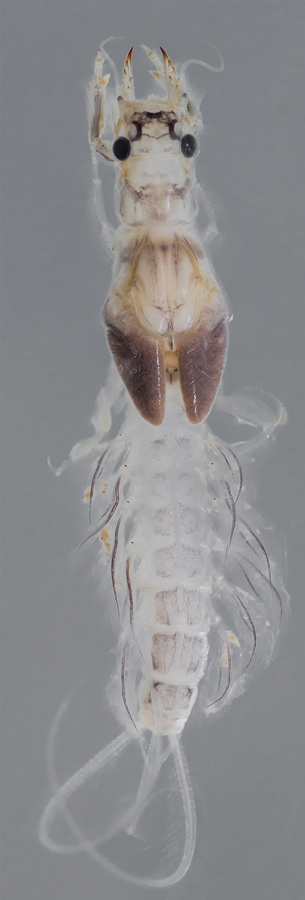Abstract
The genus Ephoron Williamson, 1802 is widely distributed around the world. In Thailand, only Ephoron indicus Pictet, 1843 was reported in 1961. In this study, a new Ephoron mayfly is described as Ephoron ookaewae sp. nov. In this new species description, the morphological characteristics of larvae and eggs in addition to adults are also shown in detail. Number of tubercles on mandibular tusks, and a median frontal process in larvae, distinguish Ephoron ookaewae sp. nov. from other Ephoron species. Their polar cap shape and a concave indentation in their eggs are also unusual. In addition, the mitochondrial DNA COI sequence data of the newly described Ephoron ookaewae sp. nov. is registered in GenBank. Registration of sequence data for the DNA barcode region of Ephoron mayflies inhabiting the Oriental region remains limited, however it will be useful for future research.
References
- Bae, Y.J. & McCafferty, W.P. (1995) Ephemeroptera tusks and their evolution. In: Corkum, L. & Ciborowski, J. (Eds.), Current Directions in Research on Ephemeroptera. Canadian Scholars’ Press Inc., Toronto, pp. 377–406.
- Barber-James, H., Sartori, M., Gattolliat, J.-L. & Webb, J. (2013) World checklist of freshwater Ephemeroptera species. World Wide Web electronic publication. Available from: http://fada.biodiversity.be/group/show/35 (accessed 15 January 2020)
- Bauernfeind, E., & Soldán, T. (2013) The Mayflies of Europe (Ephemeroptera). Brill, Leiden, 781 pp.
- https://doi.org/10.1163/9789004260887
- Brittain, J.E. (1982) Biology of mayflies. Annual Review of Entomology, 27, 119–147.
- https://doi.org/10.1146/annurev.en.27.010182.001003
- Chopra, B. (1927) The Indian Ephemeroptera (Mayflies) Part I. The suborder Ephemeroidea: Families Palingeniidae and Polymi-tarcyidae. Records of the Indian Museum, 29, 91–138.
- Dubey, O.P. (1970) Description of a new Ephemerid from India. Agra University Journal of Research (Science), 19 (3), 67–68.
- Edmunds, G.F. Jr. (1948) The nymph of Ephoron album (Ephemeroptera). Entomological News, 59 (1), 12–14.
- Edmunds, G.F. Jr., & Traver, J.R. (1954) An outline of a reclassification of the Ephemeroptera. Proceedings of the Entomological Society of Washington, 56, 236–240.
- Edmunds, G.F. Jr., Jensen, S.L. & Berner, L. (1976) The Mayflies of North and Central America. University of Minnesota Press, Minneapolis, 330 pp.
- Edmunds, G.F. Jr. & McCafferty, W.P. (1988) The mayfly subimago. Annual Review of Entomology, 33, 509–529.
- https://doi.org/10.1146/annurev.en.33.010188.002453
- Edmunds, G.F. Jr. & McCafferty, W.P. (1996) New field observations on burrowing in Ephemeroptera from around the world. Entomological News, 107 (2), 68–76.
- Folmer, O., Black, M., Hoeh, W., Lutz, R. & Vrijenhoek, R. (1994) DNA primers for amplification of mitochondrial cytochrome c oxidase subunit I from diverse metazoan invertebrates. Molecular Marine Biology and Biotechnology, 3, 294–299.
- Gaino, E. & Flannagan, J. (1995) Fine external morphology of the eggs of Ephoron album (Say) and Ephoron shigae (Takahashi) (Ephemeroptera, Polymitarcyidae). The Canadian Entomologist, 127 (4), 527–533.
- https://doi.org/10.4039/Ent127527-4
- Gillies, M.T. (1951) Further notes on Ephemeroptera from India and South East Asia. Proceedings of the Royal Entomological Society of London, Series B, Taxonomy, 20, 121–130.
- https://doi.org/10.1111/j.1365-3113.1951.tb01009.x
- Hsu, Y.C. (1937) The mayflies of China (Order Ephemeroptera). Peking Natural History Bulletin, 11 (2), 129–148.
- Ishiwata, S. (1996) A study of the genus Ephoron from Japan (Ephemeroptera, Polymitarcyidae). The Canadian Entomologist, 128 (4), 551–572.
- https://doi.org/10.4039/Ent128551-4
- Kluge, N.J. (2004) The phylogenetic system of Ephemeroptera. Kluwer Academic Publishers, New York, 456 pp.
- https://doi.org/10.1007/978-94-007-0872-3
- Lestage, J.A. (1924) Faune entomologique de l’Indochine française. Les Éphémères de l’Indochine Française. Opuscules de l’Institut Scientifique de l’Indochine, 3, 79–93.
- Navás, L. (1933) Insecta orientalia. XII series. Memorie dell’Accademia Pontifica dei Nuovi Lincei, Rome, 17 (2), 75–108.
- Ogden, T.H., Gattolliat, J.L., Sartori, M., Staniczek, A.H., Soldán, T. & Whiting, M.F. (2009) Towards a new paradigm in mayfly phylogeny (Ephemeroptera): Combined analysis of morphological and molecular data. Systematic Entomology, 34, 616–634.
- https://doi.org/10.1111/j.1365-3113.2009.00488.x
- Pictet, F.J. (1843) Histoire naturelle générale et particulière des Insectes Névroptères. Famille des Ephémérines. Baillière édit., Paris, 300 pp.
- https://doi.org/10.5962/bhl.title.48625
- Sekiné, K. & Tojo, K. (2012) The origin and distribution expansion of unisexual populations in the geographically parthenogenet-ic mayfly, Ephoron shigae (Insecta: Ephemeroptera: Polymitarcyidae). Proceeding of Arthropodan Embryological Society of Japan, 47, 33–35.
- Sekiné, K., Hayashi, F. & Tojo, K. (2013) Phylogeography of the East Asian polymitarcyid mayfly genus Ephoron (Ephemerop-tera: Polymitarcyidae): A comparative analysis of molecular and ecological characteristics. Biological Journal of the Linne-an Society, 109, 181–202.
- https://doi.org/10.1111/bij.12033
- Sekiné, K., Tojo, K. & Bae, Y.J. (2015a) Facultative parthenogenesis in the burrowing mayfly, Ephoron eophilum (Ephemerop-tera: Polymitarcyidae) with an extremely short alate stage. European Journal of Entomology, 112 (4), 606–612.
- https://doi.org/10.14411/eje.2015.074
- Sekiné K., Hayashi, F. & Tojo, K. (2015b) Unexpected monophyletic origin of Ephoron shigae unisexual reproduction strains and their rapid expansion across Japan. Royal Society Open Science, 2, 150072.
- http://doi.org/10.1098/rsos.150072
- Sekiné, K. & Tojo, K. (2019) A mayfly’s rapid transition toward unisexual populations. Biological Journal of the Linnean Socie-ty, 127 (2), 472–478.
- https://doi.org/10.1093/biolinnean/blz039
- Spieth, H. (1940) The genus Ephoron. The Canadian Entomologist, 72, 109–110.
- https://doi.org/10.4039/Ent72109-6
- Szaz, D., Horvath, G., Barta, A., Robertson, B., Farkas, A., Egri, A., Tarjányi, N., Racz, G. & Kriska, G. (2015) Lamp-Lit Bridges as Dual Light-Traps for the Night-Swarming Mayfly, Ephoron virgo: Interaction of Polarized and Unpolarized Light Pollu-tion. PLoS ONE, 10 (3), e0121194.
- https://doi.org/10.1371/journal.pone.0121194
- Tojo, K., Sekiné, K. & Matsumoto, A. (2006) Reproductive mode of the geographic parthenogenetic mayfly Ephoron shigae, with findings from some new localities (Insecta: Ephemeroptera, Polymitarcyidae). Limnology, 7, 31–39.
- https://doi.org/10.1007/s10201-006-0163-3
- Uéno, M. (1961) Mayflies of Thailand. Nature and Life in Southeast Asia, 1, 207–208.
- Ulmer, G. (1939) Eintagsfliegen (Ephemeroptera) von den Sunda-Inseln. Archiv für Hydrobiologie, Supplement, XVI, 443–692.


